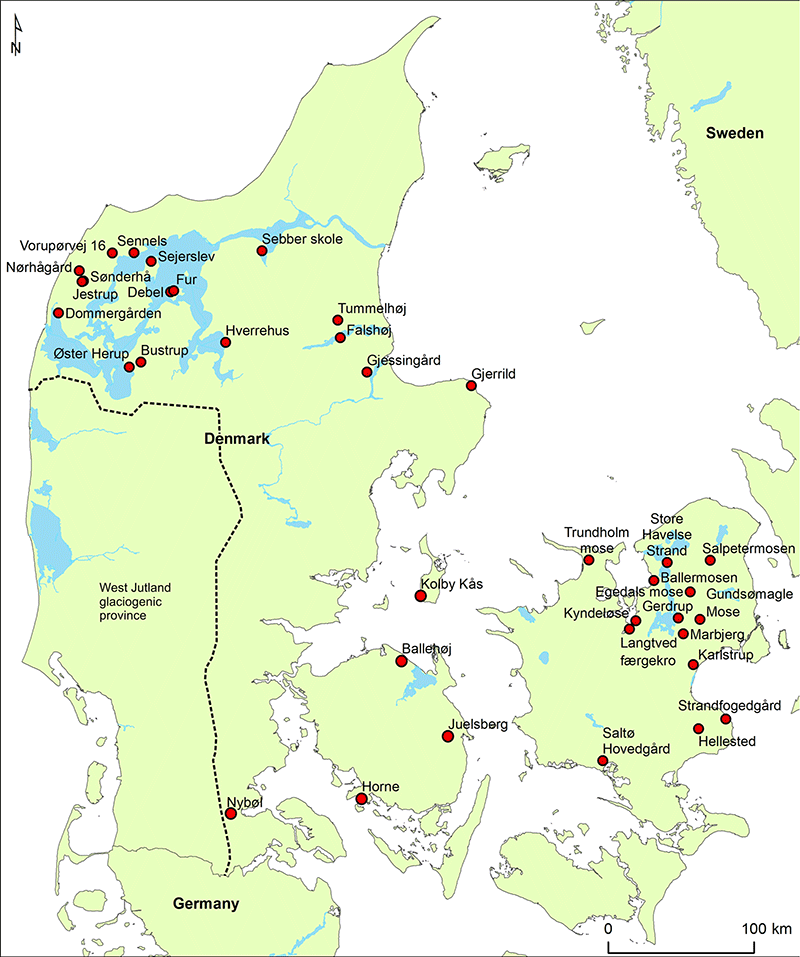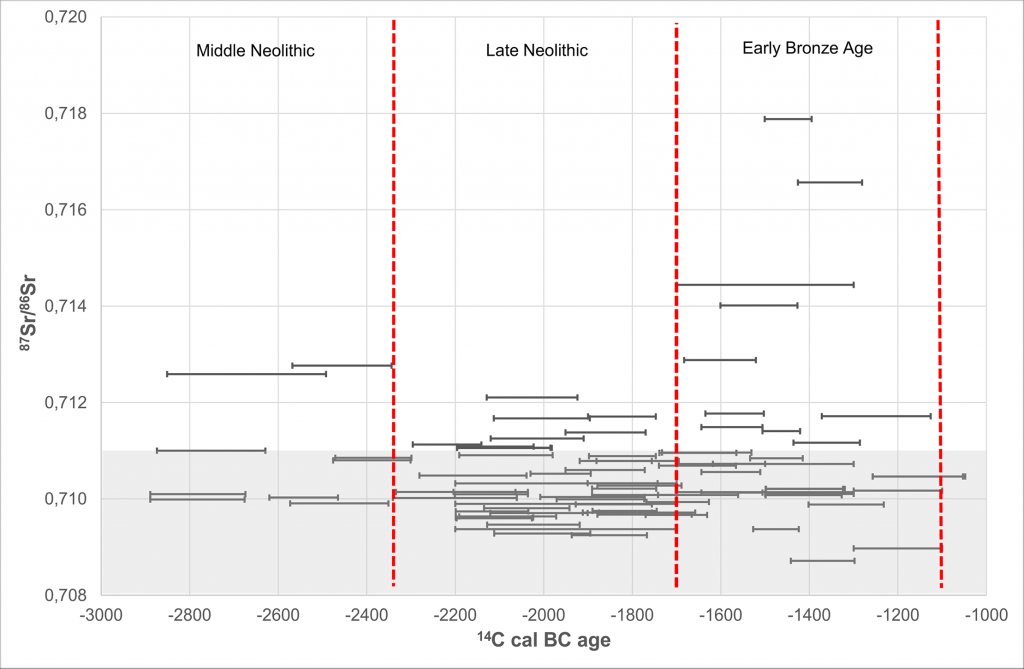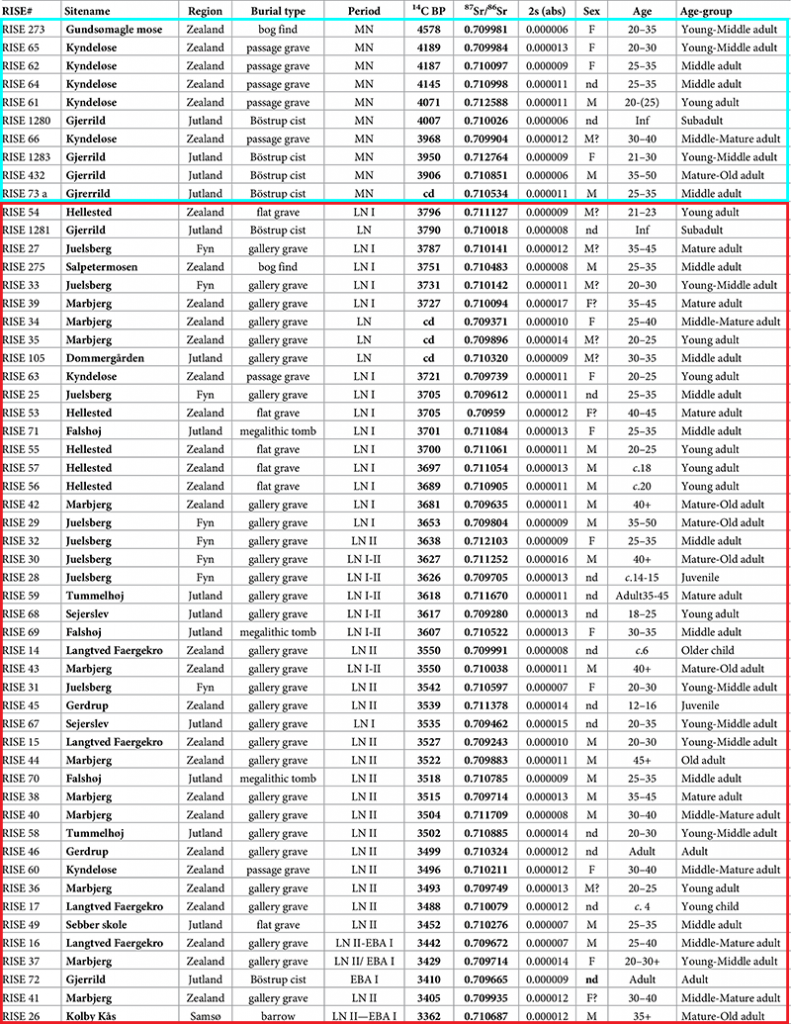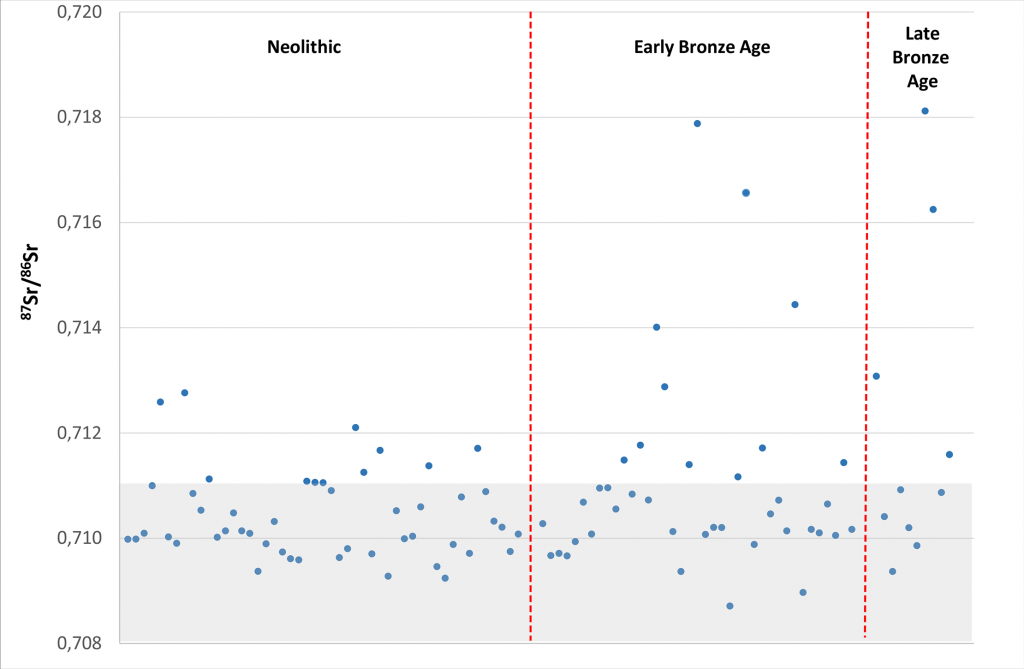New open access paper Mapping human mobility during the third and second millennia BC in present-day Denmark by Frei et al. PLOS One (2019), from the Copenhagen group (including Allentoft, Sikora, and Kristiansen) of samples whose genomic profile will probably be published soon.
Interesting excerpts (emphasis mine):
We present results of the largest multidisciplinary human mobility investigation to date of skeletal remains from present-day Denmark encompassing the 3rd and 2nd millennia BC. Through a multi-analytical approach based on 88 individuals from 37 different archaeological localities in which we combine strontium isotope and radiocarbon analyses together with anthropological investigations, we explore whether there are significant changes in human mobility patterns during this period. Overall, our data suggest that mobility of people seems to have been continuous throughout the 3rd and 2nd millennia BC. However, our data also indicate a clear shift in mobility patterns from around 1600 BC onwards, with a larger variation in the geographical origin of the migrants, and potentially including more distant regions. This shift occurred during a transition period at the beginning of the Nordic Bronze Age at a time when society flourished, expanded and experienced an unprecedented economic growth, suggesting that these aspects were closely related.

The dashed black line marks the maximum advance stage of the last glaciation (Weichselian). Drafted with public domain data from Natural Earth (https://www.naturalearthdata.com).
Strontium isotope analyses
The results of our strontium isotope analyses are presented in Table 2 and listed in chronological order according to the radiocarbon dates (in sites with multiple individuals we start with the oldest radiocarbon individual). The strontium isotope data set reveals a wide range of values from 87Sr/86Sr = 0.70871 (RISE 23, from the site of Debel) to 87Sr/86Sr = 0.71788 (RISE 20, from the site of Karlstrup). Despite the difficulties of establishing the baseline range some of the herein investigated individuals may be classified as non-locals. A few individuals have tooth enamel signatures that lie just above the upper baseline limit of 87Sr/86Sr = 0.711 and therefore, the classification of these humans as non-locals should be considered with caution. Nevertheless, the significant proportion of individuals with relatively radiogenic values suggest that about a quarter of the individuals studied herein seem to have originated from other places than from those they were buried, and hence implying a continuous degree of mobility during the 3rd and 2nd millennia BC.

Middle Neolithic
From the Single Grave Culture (SGC) which is closely related to the Corded Ware Complex in central and eastern Europe and dates from c. 2800 BC to 2200 BC, we analyzed seven of the at least ten individuals who were buried at the site of Gjerrild in eastern Jutland (Fig 1). Gjerrild is a key SGC site, as to date it has provided the most substantial skeletal material pertaining to this culture from present-day Denmark. However, it is not a typical SGC grave, but a megalithic chamber of the so-called “Bøstrup type”. The SGC pottery was decorated with cord or stamp impressions and the stone battle axes were a common feature of male equipment. Such shared traits in the Corded Ware Complex probably reflected shared occupational, social and religious characteristics. Apart from one individual who yielded a Bronze Age date, five individuals date within the period that spans from c. 2600 BC to 2200 BC, hence representing the middle and late SGC phases (Table 1 and S1 File). Of the seven individuals, three males, one female, two infants and one adult (only represented by a disarticulated mandible, and dated to the Bronze Age), all but one yielded strontium isotope signatures that fall within the local baseline range. Only the female (RISE 1283) has a more radiogenic strontium isotope signature of 87Sr/86Sr = 0.7127, which is similar to that of the male from Kyndeløse and might indicate non-local provenance. One of the individuals at Gjerrild, a mature-old adult male, who yielded a local signature (RISE 432) was accompanied by a D-type arrowhead and an amber bead which lay on his right side. He showed signs of inflammation on his lower legs, in particular on the left one. He had a healed trepanation (Fig 2). Another individual (RISE 73a, 1282), an adult male, was found with a type D arrowhead in the sternum (Fig 3).

Late Neolithic I
We sampled individuals from a total of twelve different sites that date to the Late Neolithic period (2300/2250-1700 BC).
One of these sites is Hellested on Zealand (Fig 1 and S1 File), with four flat graves containing five individuals, four young males and one mature adult female. We conducted strontium isotope analyses of enamel from all five individuals, and our results point to two individuals being characterized by local strontium isotope values. One of these individuals, the female, was buried with no grave goods (RISE 53, grave B) while the other, a young male, was buried with a fragmented bone pin (RISE 56, grave F). The other three male individuals (RISE 54, 55, 57) yielded similar strontium isotopic values that lie slightly above the local baseline range. All these individuals had been buried with early flint daggers (type I and II), and one of them (RISE 57, grave A) additionally had a ring-headed pin (Ringkopfnadel) [56]. On the basis of the presence of this ring-headed pin, Lomborg [56] suggested that these individuals had connections with the Únětice culture. Furthermore, three of them have radiocarbon dates that overlap (RISE 55, 56 and 57; Table 1).
Another Late Neolithic site is Juelsberg on the island of Funen (central Denmark, Fig 1 and S1 File) which is a gallery grave that contained at least 19 individuals. We conducted strontium isotope analyses of tooth enamel on 8 out of the 19 individuals and two of them, a male and female, yielded ratios that suggest a non-local origin (RISE 30 and 32). The grave goods comprise a (Lomborg) type I flint dagger but also some non-local type of artefacts. These consist of an early type of bone pin (type 7) mainly found in south-eastern Scandinavia, and a barbed and tanged flint arrowhead of the west-European Bell Beaker type suggesting western connections. The middle adult female (RISE 32) yielded an 87Sr/86Sr = 0.7121 and the mature to old adult male (RISE 30) yielded a 87Sr/86Sr = 0.7112. The different Sr isotope signatures of these individuals imply that they might have originated from different areas, albeit their radiocarbon dates are very similar.
The gallery grave of Marbjerg, Zealand (Fig 1), yielded 17 individuals (S1 File), and we conducted strontium isotope analyses of tooth enamel on 11 of them. The majority of the individuals were males, but females and children, too, were present. Anthropological investigations of the individuals from this site, males as well as females, indicate a relatively high life expectancy with respect to that typical for this period (S1 Table). Our radiocarbon dates revealed that this grave was in use for several hundred years from the Early Late Neolithic (2210–2030 cal BC, RISE 39) to the Late Neolithic /Early Nordic Bronze Age Period (1770–1620 cal BC, RISE 41). Despite the long-term use of this grave, 10 of the 11 individuals studied herein yielded a very narrow and overlapping range of strontium isotope values between 87Sr/86Sr = 0.7096–0.7101. Their values suggest not only that these individuals were local but that their food sources were derived from the same area over the course of several centuries. Only the tooth enamel sample of one individual, a middle to mature adult male (RISE 40), yielded a higher value of 87Sr/86Sr = 0.7117, which seems to suggest a non-local origin.
Predictions about these samples
Strontium isotope analyses only show potential movements during an individual’s lifetime, which is normally useless to assess relevant migrations if the sampling is not big enough (see more on investigating population movements). Still, if a sampling like this one shows many potentially non-local individuals from different parts of Denmark deviating from the baseline at a certain period, you can infer that something is happening within Denmark and in nearby regions.

Based on what we know now, I bet these are the most likely events in Denmark that marked the Nordic Late Neolithic with its Bell Beaker-related Dagger Period ca. 2400/2300 BC on:
- Sudden appearance of R1b-L23 lineages (probably R1b-U106 among them), originally from the Northern European Plain, ultimately from the Danube River Basin. R1a-M417 subclades, possibly prevalent in the previous period, disappear or appear rarely, to resurge later during the Bronze Age probably mostly as hg R1a-Z284, originally from the Battle Axe culture in Sweden, together with I1 – these resurgence events might be shifted to a later phase, though, and there might be some isolated R1a cases in the Danish LN, too.
- Shift of Middle Neolithic to Late Neolithic in the PCA away from the Corded Ware cluster and closer to the Bell Beaker cluster – whatever that means exactly for Danish SGC relative to Northern European Beakers, visible especially when enough samples are available.
- Evident sign of new incoming ancestry ultimately from Yamnaya-related populations, compared to earlier peoples of Corded Ware ancestry. Yes, even this far north, despite heavy admixture of Yamnaya-like Bell Beakers through exogamy with Corded Ware-like populations all the way to the north from the Danube Basin.
All this will support, once again, the expansion of Bell Beakers from Yamnaya settlers of Central-East Europe. That is probably what I will be reporting about the data as related to the Pre-Proto-Germanic homeland of the Northern European Plain, unless there is some big surprise, for example that R1b-U106 expanded later from Northern Germany, more clearly associated with later Barbed Wire Beakers or even Únětice movements, although I find this very unlikely at this point.
The above predictions are more or less evident to everyone, despite the current mistrust in the Yamnaya – Bell Beaker expansion route of North-West Indo-European, due to the prevalent nativist and/or reactionary trends in hobby population genomics and among academics. My main prediction is therefore about human behaviour:
(1) Seeing how the Copenhagen group started to describe recently South Scandinavian genetic and linguistic prehistory, their conclusions are predictable. From the introduction of this paper:
The 3rd millennium BC stands out as a period of migrations in western Eurasia, as pastoral steppe populations settled in temperate Europe after 2800 BC e.g. [1, 2]. This was also a period of cultural and genetic admixture e.g. [3]. From 1600 BC onwards, southern Scandinavia became more closely linked to the existing European metal trade networks (…)
See what they did there? No mention of the radical change that the Dagger Period brought to Scandinavia, in cultural or genetic terms (see e.g. here or here). Strange how the only thing that Kristiansen has changed since the 1980s – and only after the 2015 genetic papers – is his previous emphasis on the Dagger Period as the most relevant unifying cultural and population movement in Scandinavia, responsible for the formation of a common Nordic language, which is suddenly given as little weight as possible in all his publications, to support some imaginary continuity with the Corded Ware culture (see e.g. here or here).
(2) Only a few males from the Single Grave period are described in this sampling, and they are quite close to the arrival of Bell Beakers, so if someone is looking for closure about the “R1b from Corded Ware”, I bet there won’t be any. As with conspiracy theories of native Vasconic R1b-L51 hidden somewhere in Western Europe even after Olalde et al. (2018) and Olalde et al. (2019), the mythic native Nordic R1b-U106 of Corded Ware will remain hidden in some unsampled Corded Ware group in the minds of many, despite being already found in Bell Beaker-derived European EBA cultures of Bohemia and possibly of Hungary, too (ca. 2500-2200 BC, see SNP calls), apart from the Late Neolithic sample from Lilla Beddinge in Scania (ca. 2275-2032 BC, see SNP calls)
I hope that I am wrong, and that some scholar in the Danish group is capable of reporting the data as it is, even if it contradicts the theories of its leading archaeologist, Kristian Kristiansen. The apparent downplay of the increase in non-local origins of individuals during the Late Neolithic I period as they appear in this paper, as well as their summary of foreign migrations into Denmark which mysteriously stop with the arrival of “Steppe ancestry” ca. 2800 BC, make me think that a change in their narrative is not very likely. The cons of working with academic divos, I guess…
Related
- Yamnaya ancestry: mapping the Proto-Indo-European expansions
- European hydrotoponymy (III): from Old European to Palaeo-Germanic and the Nordwestblock
- Pre-Germanic and Pre-Balto-Finnic shared vocabulary from Pitted Ware seal hunters
- European hydrotoponymy (I): Old European substrate and its relative chronology
- European hydrotoponymy (II): Basques, Iberians, and Etruscans after Old Europeans
- Pre-Germanic and Pre-Balto-Finnic shared vocabulary from Pitted Ware seal hunters
- Bell Beaker/early Late Neolithic (NOT Corded Ware/Battle Axe) identified as forming the Pre-Germanic community in Scandinavia
- Minimal Corded Ware culture impact in Scandinavia – Bell Beakers the unifying maritime elite
- Pre-Germanic born out of a Proto-Finnic substrate in Scandinavia
- Kortlandt: West Indo-Europeans along the Danube, Germanic and Balto-Slavic share a Corded Ware substrate
- Reproductive success among ancient Icelanders stratified by ancestry
- Genomic analysis of Germanic tribes from Bavaria show North-Central European ancestry
- Germanic tribes during the Barbarian migrations show mainly R1b, also I lineages
- On Proto-Finnic language guesstimates, and its western homeland